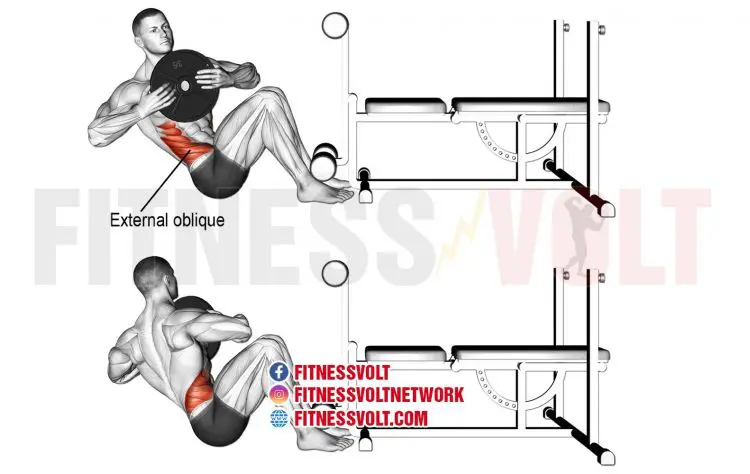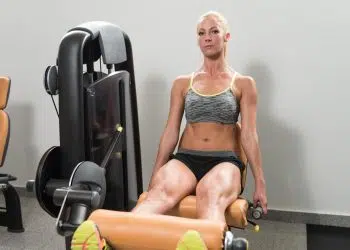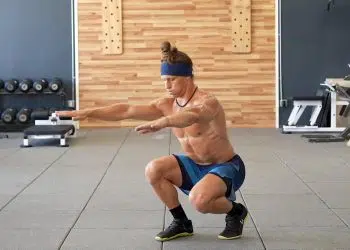When it comes to core training, a lot of exercisers are fixated on the muscle at the front of their stomachs – the rectus abdominis. This makes a certain amount of sense given that it’s the rectus abdominus that’s responsible for your six-pack.
But, as important as the rectus abdominis clearly is, it’s not the only muscle you need to develop if you want a great-looking midsection. You also need to work on your obliques.
The obliques are basically your waist muscles and provide a “frame” for your abs to show them at their best.
The functions of your obliques are lateral flexion and rotation of your spine, meaning they’re responsible for bending your torso sideways and twisting. They are especially involved in movements like throwing, punching, and kicking.
The Russian twist is one of the most popular oblique exercises, but it’s not necessarily one of the best.
Level Up Your Fitness: Join our 💪 strong community in Fitness Volt Newsletter. Get daily inspiration, expert-backed workouts, nutrition tips, the latest in strength sports, and the support you need to reach your goals. Subscribe for free!
That’s because Russian twists involve a lot of hip flexor engagement, and that can lead to lower back pain. Also, Russian twists can be a tricky exercise to master.
Common Russian twist faults include:
- Using too much weight
- Moving too fast
- Twisting the legs one way and the shoulders the other, which increases stress on the lower back – especially if you hold your feet off the floor
- Only moving the arms and not the waist
While these problems can be fixed simply by doing the exercise more slowly, using less weight, and with a more controlled action, some exercisers may find it better to simply stop doing Russian twists and do something else effective instead.
In this article, we reveal the best Russian twist alternatives for a rock-hard core.
Top 15 Russian Twist Alternatives for a Rock-Hard Core
Looking for a safer, more effective alternative to Russian twists? Here are 15 to choose from!
1. Cable Russian twist
Cable Russian twists are both safer and more effective than the traditional freeweight version. They involve no real hip flexor activity, are much more lower back-friendly, and keep your muscles under constant tension.
So, if you still want to do Russian twists but want to get more bang for your workout buck, this is the exercise for you!
Learn how to do cable Russian twists here.
2. Standing cable twist
This exercise is sometimes called a standing cable Russian twist. It works the same muscles as regular Russian twists, but it’s much more lower back-friendly. And, like all cable exercises, it also keeps your muscles under near-constant tension, leading to a much more effective workout.
Read all about standing cable twists here.
3. Cable wood chop
Cable wood chops are very similar to standing cable twists. The main difference is that you move diagonally, which may increase oblique engagement. This exercise also involves more lower body movement, which makes it more functional as it mirrors the demands of swinging a racket, throwing a punch, and, indeed, chopping wood. As such, this is an excellent exercise for athletes.
Learn how to do cable wood chops here.
4. Pallof press
Named after physical therapist John Pallof, this exercise is a little different because it involves using the obliques and core to prevent movement rather than initiate it. As such, it’s an effective core stability exercise.
As well as working your midsection, the Pallof press integrates your core with your arms and legs, making it a functional, full-body exercise.
Reads more about this marvelous midsection exercise here.
Level Up Your Fitness: Join our 💪 strong community in Fitness Volt Newsletter. Get daily inspiration, expert-backed workouts, nutrition tips, the latest in strength sports, and the support you need to reach your goals. Subscribe for free!
5. Oblique crunches
You don’t always have to use weights to train your obliques. In fact, there are several bodyweight-only exercises that deliver a very effective obliques workout. Oblique crunches are straightforward to do but, done using a slow tempo to minimize momentum, you’ll definitely feel the target muscles working.
How to do it:
- Lie on your left side with your hips square and your legs bent. Place your left hand on the right side of your waist to provide feedback from the muscles you are working on. Put your right hand on the side of your head.
- Use your uppermost obliques to flex your torso and draw your right shoulder down toward your hip. Move slowly and deliberately, contracting your obliques as hard as you can.
- Pause at the top of each rep for 2-3 seconds, lie back down, and repeat.
- Roll over and do the same number of reps on the opposite side.
6. Stability ball oblique crunch
Abs exercises using a stability ball are generally more challenging than the same exercise done on the floor. Using a ball increases your range of motion and creates instability, leading to increased muscle recruitment. Try this variation if regular oblique crunches aren’t demanding enough for you.
How to do it:
- Lie on your side on a stability ball, so the ball is in the curve of your waist. Brace your feet against the base of a wall for balance.
- Keeping your hips and shoulders square, wrap your upper body around the curve of the ball, and then use your obliques to curl your uppermost shoulder toward your hip.
- Extend your body back over the ball and repeat.
- The higher you raise your arms, the longer the lever becomes, and the more challenging this exercise will be. You can also do this exercise while holding a weight plate or dumbbell to your chest.
7. Oblique cable crunch
The great thing about oblique cable crunches is that you can adjust the weight to match your current strength and training goal – you can go as light or as heavy as you wish! Do this exercise kneeling or standing as preferred.
Learn how to do this awesome oblique exercise here.
8. Single-arm farmer’s walk
While the single-arm farmer’s walk looks nothing like a Russian twist, it’s actually a very effective oblique exercise. During single-arm farmer’s walks, you’ll need to use your obliques to keep your torso upright.
You are stronger isometrically than you are concentrically or eccentrically, which means you can go really heavy on this exercise, giving your obliques a serious strength-building workout.
How to do it:
- Hold a heavy dumbbell or kettlebell in one hand, arm down by your side. Brace your abs to keep your torso perfectly upright.
- Walk around your training area until your grip fails or you cannot stay upright.
- Switch hands and repeat.
9. Dumbbell side bend
The main advantage of dumbbell side bends over bodyweight oblique exercises is that you can use progressively heavier weights to make them more challenging. However, don’t hold a dumbbell in each hand in an attempt to train both sides of your waist at once.
One weight counterbalances the other, turning what should be a good oblique exercise into more of a forearm workout!
Learn how to do dumbbell side bends the right way here!
10. Side plank leg lift
Regular side planks provide your obliques with a good workout. But, like most bodyweight abs exercises, all too soon, they will lose some of their effect, and you’ll need to do them for longer and longer. This side plank variation involves a leg raise which makes them more challenging. You can also do this exercise for reps instead of a predetermined time.
How to do it:
- Lie on your side with your body straight and resting on your bent arm. With your legs together, raise your hips up so your weight is supported on your lowermost foot and arm only. Brace your abs.
- Without raising or lowering your hips, lift your uppermost leg until your foot is toughly level with your shoulder.
- Lower your leg and repeat.
- Swap sides and do the same number of reps with the other leg.
11. Side Jackknife
Looking for a bodyweight oblique move that you can do anywhere and anytime that’s still challenging enough for even advanced exercisers? Look no further than the side jackknife. This simple exercise is deceptively demanding, and all you need to do it is an exercise mat.
How to do it:
- Lie on your side with your body straight. Your hips and shoulders should be stacked, i.e., vertical and not leaning forward or back.
- Place your uppermost hand on your temple and push your elbow back to open your chest.
- Extend your lowermost arm out in front of you for balance.
- Contract your obliques, brace your abs, and lift your shoulders off the floor. Simultaneously lift your top leg. Hinge at the waist like a folding jackknife.
- Lie back down and repeat.
- Do the same number of reps on both sides.
12. Suitcase deadlift
This is another exercise that looks nothing like Russian twists but still works many of the same muscles. The name comes from how this exercise makes you look like you are bending down to pick up a bag or suitcase.
It involves bracing your abs and using your obliques to maintain an upright torso while doing single-arm deadlifts. It’s a very functional exercise that’s ideal for building full-body strength and stability.
How to do it:
- Set up your barbell, so it’s roughly mid-shin height. You can also use a single dumbbell or a kettlebell. Stand sideways to your weight.
- Without leaning sideways, feet shoulder-width apart, squat down and grab the weight with your nearest hand. Drop your hips, lift your chest, brace your core, and look straight ahead.
- Drive your feet into the floor and stand up, ensuring you do not lean toward or away from the weight.
- Lower the weight back to the floor and repeat.
- Rest a moment and then do the same number of reps on the opposite side.
13. Shovel lift
The shovel lift is one of the most unusual core exercises around. As the name suggests, it replicates using a shovel to dig a ditch. The shovel lift works your obliques, rectus abdominus, and all the other muscles involved during Russian twists. However, your arms and legs will get a great workout too.
How to do it:
- Leaving one end of your bar on the floor, bend down and grab the other end with a mixed grip, hands slightly wider than shoulder-width apart. The closer to the end of the bar you stand, the harder this exercise becomes, so position your hands accordingly.
- Stand up so that the bar is angled down toward the floor. Bend your knees slightly and brace your core tight. Do not round your lower back.
- Using your entire body, lift the weighted end of the bar up until it is at or above head height. Imagine you are digging dirt and trying to lift it onto a raised truck bed.
- Lower the end of the bar back to the floor and repeat. Don’t bounce it, as that will just damage the bar.
- On completion of your set, rest a moment and then repeat but, this time, stand on the opposite side of your bar and reverse your hand position to ensure you train both sides of your body equally.
14. Landmine full contact twists
For an even more powerful oblique exercise, give landmine full contact twists a try! This exercise not only works your abs and obliques but your arms and shoulders, too. Core exercises don’t come much more functional than this!
No landmine? No problem; just use a standard Olympic bar with one end wedged in a corner.
How to do it:
- Lift the bar and hold it above your head with your hands close together, both palms facing inward. Brace your core and pull your shoulders down and back. Press the bar forward and down
- Maintaining core tension, turn your shoulders and arms and lower the landmine bar down to one side. Turn your hips in the same direction as your arms.
- Raise the weight back up and then repeat on the opposite side.
- Continue alternating sides for the duration of your set, pushing your arms forward and down the entire time.
15. Rotational medicine ball toss
This is a dynamic movement that will help build explosive power in your entire body. Not just your obliques, but in your abs, quads, glutes, arms, and shoulders, too. It’s a favorite of CrossFitters and athletes looking to take their strength, endurance, and power to the next level.
How to do it:
- Holding a medicine ball, stand sideways onto a strong wall. Bend your knees slightly for balance. Brace your core and pull your shoulders down and back.
- Keeping your arms relatively straight, turn your upper body away from the wall and then rotate toward it as fast as you can, throwing the ball as hard as possible.
- Catch the ball as it bounces back to you and repeat.
- Do the same number of reps on both sides.
More Alternatives
- Best Cable Crunch Alternatives
- Crunch and Sit-Up Alternatives
- Hyperextension Alternatives
- Medicine Ball Slam Alternatives
- Box Jump Alternatives
- Seated Cable Row Alternative
- Cable Crossover Alternatives
- Pull Up Alternatives
Russian Twist Alternatives – Wrapping Up
While there is nothing inherently wrong with Russian twists, doing them improperly could cause injury. Also, while they ARE an effective exercise, if you do them too often, they’ll gradually start to lose their potency, making your workouts less productive than they should be.
So, shake up your core workouts with these Russian twist alternatives. Each one is every bit as good but is also different enough to keep you out of any potential training ruts.
That said, if you enjoy Russian twists, there is no need to drop them from your workouts completely. However, you’ll still probably benefit from supplementing them with a couple of exercises from this list. Hit your obliques from different angles using a range of exercises to build a core you can genuinely be proud of!
Interested in measuring your progress? Check out our strength standards for Cable Crunch, Seated Cable Row, Deadlift, and more.









